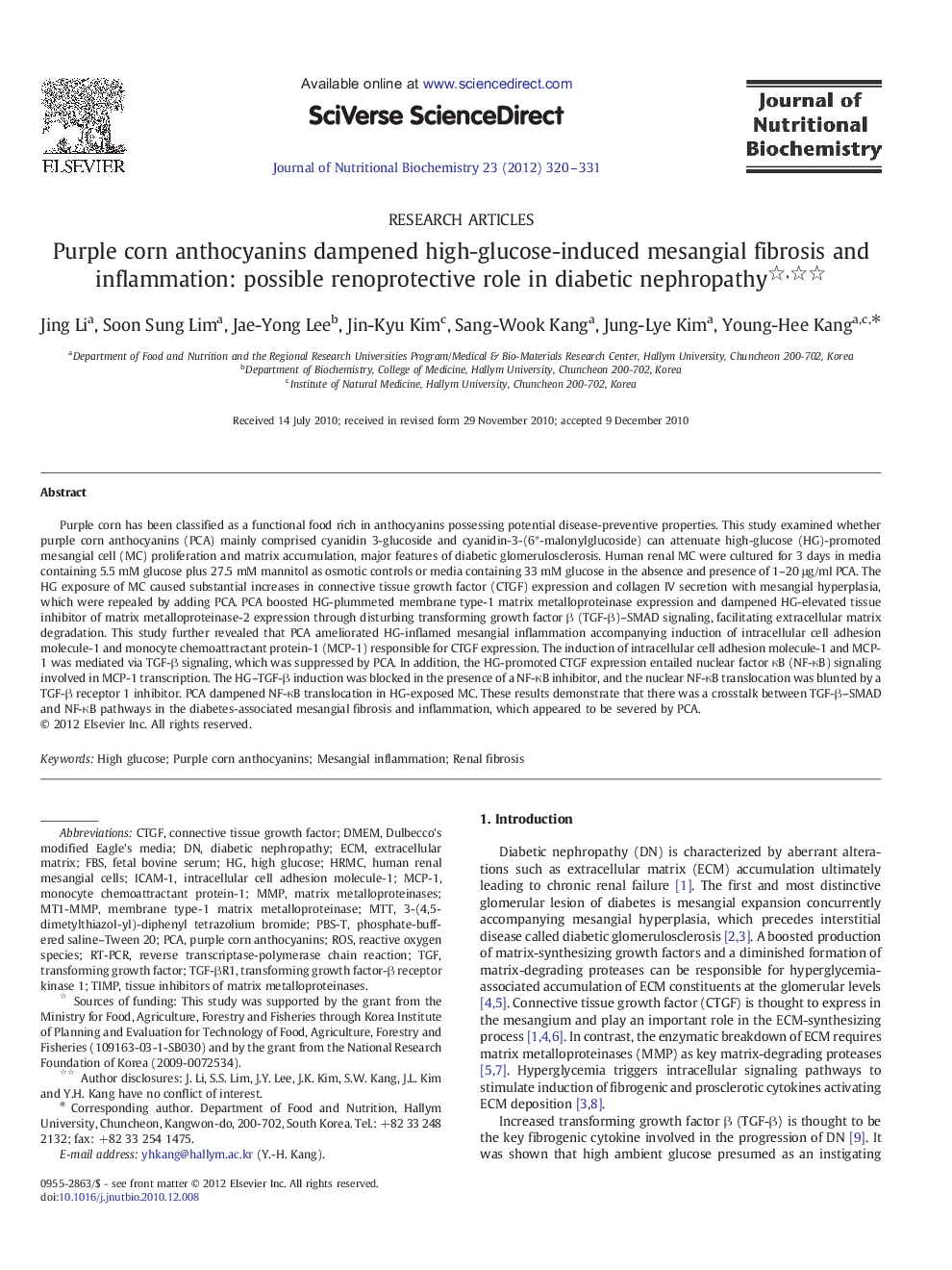| Article ID | Journal | Published Year | Pages | File Type |
|---|---|---|---|---|
| 8337656 | The Journal of Nutritional Biochemistry | 2012 | 12 Pages |
Abstract
Purple corn has been classified as a functional food rich in anthocyanins possessing potential disease-preventive properties. This study examined whether purple corn anthocyanins (PCA) mainly comprised cyanidin 3-glucoside and cyanidin-3-(6â³-malonylglucoside) can attenuate high-glucose (HG)-promoted mesangial cell (MC) proliferation and matrix accumulation, major features of diabetic glomerulosclerosis. Human renal MC were cultured for 3 days in media containing 5.5 mM glucose plus 27.5 mM mannitol as osmotic controls or media containing 33 mM glucose in the absence and presence of 1-20 μg/ml PCA. The HG exposure of MC caused substantial increases in connective tissue growth factor (CTGF) expression and collagen IV secretion with mesangial hyperplasia, which were repealed by adding PCA. PCA boosted HG-plummeted membrane type-1 matrix metalloproteinase expression and dampened HG-elevated tissue inhibitor of matrix metalloproteinase-2 expression through disturbing transforming growth factor β (TGF-β)-SMAD signaling, facilitating extracellular matrix degradation. This study further revealed that PCA ameliorated HG-inflamed mesangial inflammation accompanying induction of intracellular cell adhesion molecule-1 and monocyte chemoattractant protein-1 (MCP-1) responsible for CTGF expression. The induction of intracellular cell adhesion molecule-1 and MCP-1 was mediated via TGF-β signaling, which was suppressed by PCA. In addition, the HG-promoted CTGF expression entailed nuclear factor κB (NF-κB) signaling involved in MCP-1 transcription. The HG-TGF-β induction was blocked in the presence of a NF-κB inhibitor, and the nuclear NF-κB translocation was blunted by a TGF-β receptor 1 inhibitor. PCA dampened NF-κB translocation in HG-exposed MC. These results demonstrate that there was a crosstalk between TGF-β-SMAD and NF-κB pathways in the diabetes-associated mesangial fibrosis and inflammation, which appeared to be severed by PCA.
Keywords
ECMMT1-MMPTGFPBS-TMCP-1CTGFRT-PCRICAM-1HRMCFBSDMEMMMPMTTPCAROStissue inhibitors of matrix metalloproteinasestransforming growth factorDulbecco's modified Eagle's mediaTIMPfetal bovine serumConnective tissue growth factorrenal fibrosisExtracellular matrixMatrix metalloproteinasesmembrane type-1 matrix metalloproteinaseDiabetic nephropathyReverse transcriptase-polymerase chain reactionmonocyte chemoattractant protein-1high glucoseReactive oxygen species
Related Topics
Life Sciences
Biochemistry, Genetics and Molecular Biology
Biochemistry
Authors
Jing Li, Soon Sung Lim, Jae-Yong Lee, Jin-Kyu Kim, Sang-Wook Kang, Jung-Lye Kim, Young-Hee Kang,
